Photo: Paul Rudderow
2015 is almost here, which means new signings, a new season, and new playoff hopes for Philadelphia Union fans.
But before we jump ahead, let’s take one final look at 2014. What really happened? What do the numbers say? And what does the Union really need to make the postseason in this coming campaign?
When the team failed to reach the playoffs this year, one narrative that was spun by myself and others was the idea that the offense faltered down the stretch.
It’s true, to a certain extent.
The bad patch was a three game stretch that extended into October, with the Union failing to score in back-to-back games against Houston (draw) and D.C. United (loss). The club then meandered through a 1-1 draw with Chicago before a defensive breakdown against Columbus resulted in a 3-2 loss and elimination from postseason contention.
It’s true that a DP striker could solve a lot of problems for this team, but that’s true for most clubs in Major League Soccer. When Conor Casey and Sebastien Le Toux cooled off, the team did struggle, but it was probably the defense, extending back to John Hackworth’s tenure, that ultimately cost the club in 2014.
Just looking at a few basic stats, here’s how 2014 played out:
- Goals scored: 51 (tied for 9th in MLS, tied for 4th in the east)
- Goals conceded: 51 (13th-worst in MLS, 4th-worst in the east)
- Wins: 10 (ranked 14th in MLS)
- Pass success: 76.8% (15th out of 19 teams)
- Possession: 48% (overrated, especially when the team carved out a successful counter-attacking shape)
- Shots per game: 13.7 (tied for 5th best in the league)
- Shots on target per game: 4.5 (tied for 11th)
Only these teams conceded more goals than Philly: Toronto (54), Houston (58), Montreal (58), Portland (52), Chivas (61), Colorado (62)
Here’s a closer look at the season, which I’ll divide in half by manager.
John Hackworth’s tenure (Mar. 8 to June 7)
- Games played: 16
- Wins: 3
- Losses: 7
- Draws: 6
- Goals scored: 23 (13 through the first 12 games, 10 in the final 4 games)
- Goals conceded: 27 (15 through the first 12 games, 12 in the final 4 games)
- Goal differential: -4
There were a couple of different storylines for Hackworth’s part of the season.
First and foremost, the final four games of his tenure provided some real statistical outliers. The club scored 10 goals in the final four games, and conceded 12 in that same stretch, so it looks odd on paper. When the offense finally got going, the defense was very poor.
The story in March and April was finishing. The Union just couldn’t seem to close out a game. It started with the season opening draw in Portland, then carried over in the draws with Montreal and Chicago just a few weeks later.
The offense hit a real rough patch in mid-April, beginning with a 2-1 loss in New York. The Red Bulls went down to 10 men in the second half, and Philly couldn’t find the back of the net until the 80th minute. The offense would go on to score just two goals in the next four games.
By the time the offense got it turned around, the Union’s makeshift defense had fallen apart.
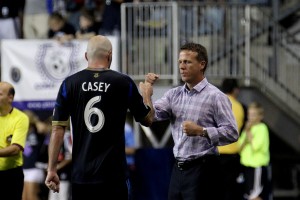
The offense started to click at the end of May, but John Hackworth’s defense ultimately cost him his job. Photo: Paul Rudderow.
With Austin Berry out of favor and injured, and the Aaron Wheeler experiment completed, Hackworth turned to right back Sheanon Williams to move inside to center back. Even before trying this setup, he had a right back playing on the left (Ray Gaddis) and a center back pairing that included a forward (Wheeler) and a midfielder (Amobi Okugo).
The defense shipped five goals to New England, four goals to Los Angeles, and three more to Vancouver. Ironically, the offense had its best stretch of the season in that same time period, when it scored 13 goals in just five games. That included three against the Revs, three against Chivas USA, and three against the Whitecaps.
For much of the early part of the season, it just never seemed like there was any consistency in offense or defense. Hack was let go on June 10.
Jim Curtin’s tenure (June 11 to Oct. 26)
- Games played: 17
- Wins: 7
- Losses: 5
- Draws: 5
- Goals scored: 29
- Goals conceded: 24
- Goal differential: +5
These numbers don’t include the run to the U.S. Open Cup final. If you added those games, it would look something like this:
- Games played: 22
- Wins: 10
- Losses: 6
- Draws: 6
- Goals scored: 38
- Goals conceded: 30
- Goal differential: +8
First, you have to admit that the offense started clicking while Hackworth was still in charge. That carried over into Jim Curtin’s first couple of games.
The team continued its onslaught with three goals at New England, three goals against Colorado, and three goals against New York.
If you combine the final four games under Hackworth and the first four games under Curtin, this is what it looks like: Eight games, 20 goals scored, 19 conceded, three wins, two draws, three losses.
In a lot of ways, that stretch tells the story of the season. The team averaged 2.5 goals over an eight game stretch, but only managed three wins and 11 total points. The point productivity did not match up with the offensive output.
- May 17: Union 3-5 New England
- May 25: Union 1-4 Los Angeles
- May 3: Union 3-0 Chivas USA
- June 7: Union 3-3 Vancouver
- June 28: Union 3-1 New England
- July 4: Union 1-2 FC Dallas
- July 12: Union 3-3 Colorado
- July 16th: Union 3-1 New York
The interesting thing is that those numbers didn’t necessarily carry over into the U.S. Open Cup games on June 17 and June 24. The Union struggled to extra time wins against Harrisburg and NY Cosmos before the July 8 2-0 home win against New England.
Either way, this midsummer stretch was really the most interesting and important cross-section of the season.
The problem with Jim Curtin’s tenure is that the team really didn’t have any margin for error. The club had dug itself such a huge hole that three or four late-Summer losses would essentially keep it out of the postseason.
The Aug. 15 loss in Houston was expected after Philadelphia had played Dallas to extra time in the U.S. Open Cup semifinal only three days before.
And whether it’s unpopular or not, I’ll go ahead and say the Union got lucky during the three-game win streak that began on August 24. Philly coughed up a two-goal lead but ended up beating a terrible San Jose team at home. The club then saw Toronto FC in twice in a four-day span, taking on a team that was going through turmoil and breaking in a brand new head coach.
Sep. 13 is really where it started to go wrong. The Union needed a stoppage time penalty kick to salvage a 2-2 home draw with New York. Then, the offense faltered in a 0-0 home draw with Houston. That preceded a 1-0 road loss to D.C. United.
The late collapse to Chicago and the three-goal meltdown versus Columbus ultimately saw the team eliminated from playoff contention.
So what’s the story here?
There was obviously no way the offense could keep up its midsummer pace. The defense ultimately collapsed in the home loss to Columbus. I’m also buying into the idea that the loss in the Open Cup final probably had a physical and psychological effect on the rest of the season.
There’s also the idea that Conor Casey and Sebastien Le Toux went cold in the fall, and there may be some truth to that. Casey scored in both Toronto games, then didn’t find the net for the rest of the season. Le Toux’s injury against D.C. at the end of September kept him out of the next home game against Chicago, and he scored just one goal in September and October.
But it’s interesting to look at some of the offensive stats in the summer. Take a look at these charts for “penalty area entries”:
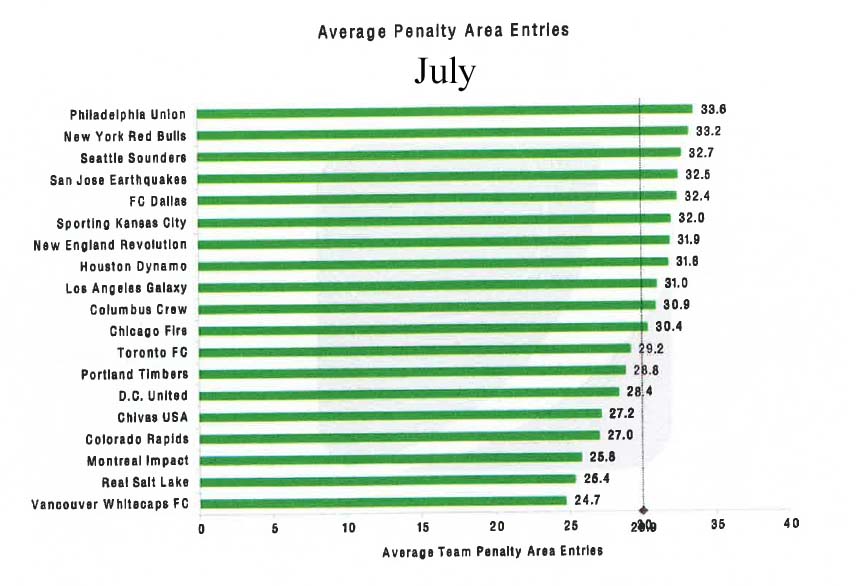
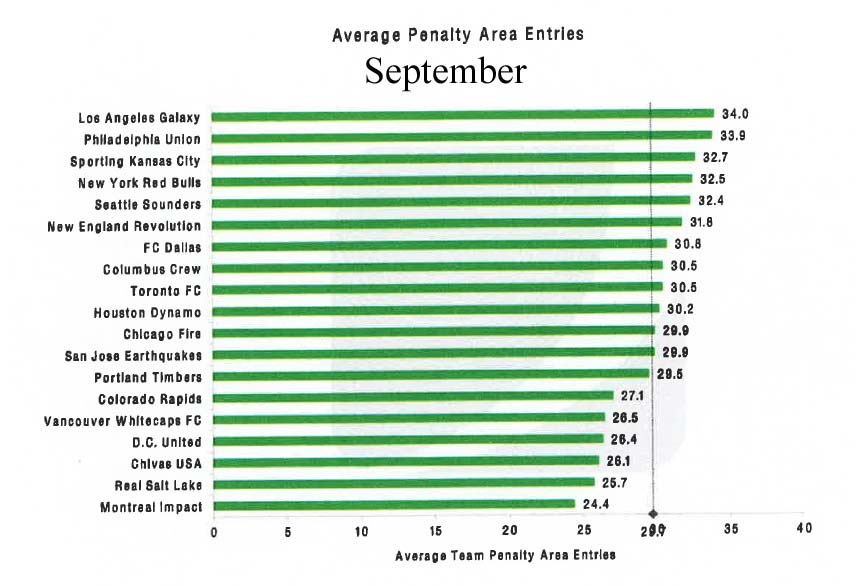
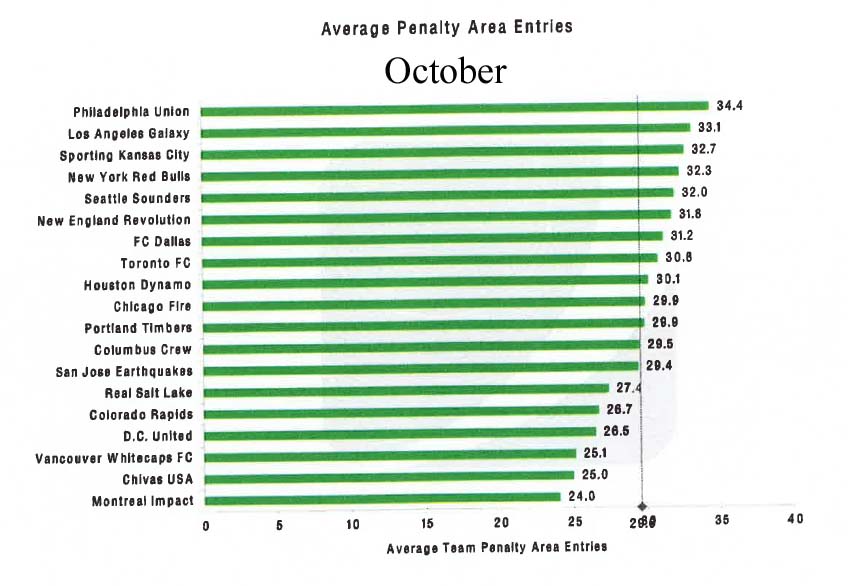
Surprisingly, Philadelphia was at the top of the league for many months in the category of “average penalty area entries”.
You’ll hear a lot of people talk about “final third entries” these days, and that’s a statistic that measures passes delivered into the opponent’s third of the field. We usually look at long passes, ground passes, short passes, flicks, and through balls when we calculate that stat.
These charts are a bit different, as they only measure the number of times that a club gets into the penalty area during the course of the game. You can see that the Union was right up there with the best clubs in the league for much of the Summer. It just seemed like they weren’t finishing as many chances as they created. There also isn’t a ton of variation from top to bottom, but you see a club like Montreal that just was not getting forward at all.
Conclusions
- The offense wasn’t nearly as bad as it seemed. The team actually scored the same amount of goals (51) as Eastern Conference champion New England. The team scored more goals than Kansas City (48) and just four fewer goals than a New York team that included Bradley Wright-Phillips and Thierry Henry.
- The issue with the offense is that there isn’t a game-changer. This is your Designated Player. The Union has never had a 15-goal scorer, despite balanced contributions in goals and assists from Sebastien Le Toux in four out of five seasons. In the 4-2-3-1 or 4-3-3, you rely a lot on your wide midfielders and forwards, and Philly didn’t see a ton of contribution on the left until Andrew Wenger started to settle in to a new position.
- There needs to be more consistency going forward. The Union got into the box and scored goals in bunches, but went through a couple of dry spells that cost the team a lot of points.
- The shots/on-goal ratio was too low. Philly was in the top half of the league in total shots (467) but in the bottom half when it came to accuracy (153 SOG). A little less than one-third of shots were put on frame. By comparison, Seattle put 187 out of 470 shots on target. That’s closer to 40%. The Union averaged 13.7 shots per game and 4.5 shots on goal per game.
- The Union led the league in corner kicks with 211. They were also near the top of MLS with seven penalty kick attempts (all seven successful). Both of these numbers complement the penalty area entries statistic, which suggests to me that, overall, the team was more committed to getting into the final third.
- Carlos Valdes needs a rest. The defense wasn’t exactly airtight when he returned after World Cup duty. If Carlos sticks around for 2015, he should be a lot better than he was in the Fall.
- The team needs the fullbacks to overlap and join the attack. Surprisingly, Philly led the league in crosses per game, but they weren’t getting much offense from Ray Gaddis on the left, who averaged less than one cross per game. Most of the time, you’d see Cristian Maidana float out wide and cross inside, or Sheanon Williams put a ball into the box from the right side. As far as Gaddis, this lack of offense isn’t necessarily his fault. After all, he is a right-footed fullback playing on the left. There’s nothing harder than playing the overlap on your weak foot and trying to cross into the box. I think this is why Curtin rates Fabinho higher than we do.
- The team needs more goals from Vincent Nogueira and Cristian Maidana. Curtin talked about this after the season. Maidana had two goals and eight assists, but Nogueira added just two goals and three assists. Even in the No. 8 role, Nogueira is good enough to contribute at least 4 goals/6 assists in 2015. Maidana can easily reach six goals/10 assists in his advanced role. Each of these guys had the same amount of goals as Leo Fernandes, Brian Brown, and Pedro Ribeiro.
- The defense needs to be in place from the beginning of the season. You just can’t have a forward, a midfielder, and an out-of-position fullback playing on the same back line in 2015. The best defenses in MLS have continuity and familiarity with one another. That’s also contingent on what position Maurice Edu plays in 2015.
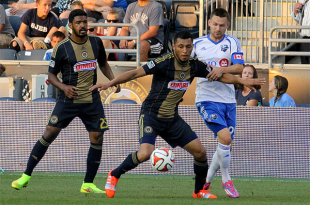

Wow. Really great, in-depth analysis, Kevin. Stats obviously aren’t everything, but they really do support what I felt about this season – it was some of the most attacking/exciting football the Union have played in all five seasons. If they just had a little more stability in the back, they could have been a real contender. Ultimately, I don’t believe it was tactical decisions that lead to the poor defensive numbers. I think it came down to individual execution. I hope Curtin doesn’t drastically change the gameplan, because despite the results, the team was very entertaining to watch this year.
I got some different conclusions from the stats you presented, Kevin, (kudos for compiling all of those btw. It’s great work), especially from the penalty area entries. The conclusion you draw is that our offense wasn’t nearly as bad as it seemed, and that’s correct. But I think you meant to say that our attackers weren’t nearly as bad as they seemed, and that would be incorrect and contradictory, especially considering you state that we have a poor shot-on-target percentage. The fact that we were consistently in the top three in penalty area entries is a testament to our attacking midfield, but combined with the fact that we were essentially mid-table in goals scored is proof that our strikers were as bad as they seemed; they really need to improve their finishing. So we don’t just need a DP striker, because our current starters stats’ show that they’re bench material at best. We need a full on revamp at the striker and winger position. This means dropping Hoppenot, Hernandez, Wheeler and Cruz. These four are reserve material at best, and together they amount to $310,000 of salary, which would be enough to sign the best non-DP striker available. Considering we also have Le Toux, Wenger, Casey, Sapong, and McLaughlin, I’m wondering why the four poorer strikers/wingers are even on the roster. Surely we don’t need 9 players for 3 positions.
.
Secondly, and less importantly, is the story that our possession and pass percentage stats show. You concluded that we just maintain a really good counter-attacking shape. But if that were the case, our possession might still be as low, but our passing percentage would be better. Of course, I think we have (had, now that Okugo is gone and Edu is looking better for CB) one of the best midfields in the league, so it could be that the stats are skewed by Hackworth’s tenure (when we were trying to play more possession style), and we do actually have a good counter-attacking shape.
.
Regardless of the conclusions drawn, this was a great piece. Thanks for taking the time to compile all of the stats and input some analysis.
You’re right, I think the possession stat might be a bit misleading overall, because Hack’s teams generally won that battle in March and April. I’d have to go game by game to see how that differentiated with the counterattacking style that they played under Curtin.
I think you could probably make a lot of conclusions about the offense. If you add 2 more goals from Maidana and 2 more goals from Nogueira, then everything looks a hell of a lot different. They are a large part of why the numbers skew in one direction.
Again, I think it goes back to that weird stretch of 8 games in the summer, where the offense was on the fire but the defense was equally poor. There were at least 6-8 points left on the table during that run, and if it played out differently, maybe Hack would still be in charge.
Excellent job Kevin as usual. To me it all shows the potential and the opportunities missed if the team would have just gotten the pieces to be elite in this top market. No one foresaw the injuries or other issues but they became magnified because of feckless ownership, management and coaching. Robbing Paul to pay Peter on and off of the pitch instead of addressing areas of obvious weakness and delusions of depth that didn’t exist. The stats also say to me that the other teams were better at positioning themselves as playoff teams while the Union again gave all they could but management,coaching,depth and talent left them wanting when they really needed it. The Union were not a playoff team nor a playoff organization let alone contenders.
This is an easy answer. The Philadelphia Union need to partner with a River Plate, Cornithians, Fluminese, Athletico, Cruz Azul (my personal hope) et. al ad infinitum…. ad infinitum et. al done. simple. easy.
.
For the record, my response came before even reading the column that is how strongly I feel about this. Welcome to looking up at NYCFC every year. Every Year!
2015. Oh and one other thing: Vision. Philosophy. Plan.
.
Rattle on with my drum. Rattle on.
.
easy.
.
simple.
Coming into the season, I fully expected 10 goals from the combination of Chaco and Nogs (I am confident Hackworth did too) If that happens, results likely would have been much different.
No matter who we have up top, those guys have to hit the target better. if we are playing the same system in 2015.
I’m hoping it was the transition to a foreign country and playing first-team football over a full calendar year. I expect more from them this season.
How well does the up and down curve of the offense’s effectiveness track with the presence of Christian Maidana playing at attacking central mid? I anticipate that the defense will be better because more settled with a more assertive keeper. Last season we had no effective answer when Maidana was hurt as an attacking center mid sub. We still don’t. We need that as much as we need a striker.
what we really need is another goalkeeper.
Staggering when broken down. Great work and some smart comments!
Great work, Kevin! How about “in game” stats? The Union’s lack of depth was sorely exposed down the stretch. Breaking: Casey and LeToux are a year older. Do we need a DP striker more than we need a reliable quality bench for our forwards and wings? Is our single biggest need a true left back? (I thought Fabhino was protected as trade bait.) Can these players produce: Berry (for Valdes), Wheeler (for Casey), Brown (for Wenger), Hoppenot (for LeToux)and Fernandes (for Maidana)? If not, spend to replace them so we can hold leads with better options than Cruz, Fred & players out of position.
I agree philpill. Seeing it laid out in print the way you put it is like being drenched with a bucket of ice water. I recall feeling at times like the Union were giving up as soon as substitutions were made. The drop off in skill from starters to subs was like a black hole. Even some of out starters would be lucky to see the bench on most teams. The Union have fooled themselves again in thinking that Fabhino has trade value. As for Berry, I think the jury is still out. I see his first year with the Union as crappy luck spurred on by an organization in constant flux and lousy coaching and staff decisions. One thing Curtin can hopefully do is work with Berry in a way that only the 2 of them understand because of similarities.
This confirms a lot of what I felt watching games this year: missed chances and baffling late game defensive breakdowns. And those defensive gaffes were the biggest part of keeping us out of the playoffs this year.
I remain optimistic that the Union will be a top 5 team in the East this year, and not because I think the conference will be weaker (I think Orlando and NYCFC are going to make the conference tougher than last year). I’m eager to see what January brings.
We need a #6…badly. One that can link the halves, as well as cover the back line.
.
We need a legitimate striker…like a real one.
.
A LB would be nice.
.
Most of all, a tactical approach.
Hasn’t the six been solved? We have a once national team player for that position who easily has 3 years of top form left. I wasn’t for Edu winning the job over Okugo but seems silly to me to put him as a CB now. Truthfully the best help he can be for the CB position is as a HDM. Food for thought is all TBH.
I thought they were talking about keeping him at CB. I hope he is our 6!!
Agreed- allocate the money to striker, LB or depth IMO.
Edu needs to play a holding DM……stay home, destroy and create….thats what he was raised to do!
….and let Nogs dictate and switch the point of attack
give Pfeffer more time in the OM spot too. I think with the pedigree the kids got….and how long he has been on our books….give him a shot there. I still think he could be better in there than Madaina. Clubs across the pond put their kids in CL matches to see if they can sink or swim…why can’t we give Pfeffer more time? We could get away with two skill guys in there if Maurice is their cover as a holding DM.
The better soccer teams in Europe ALL dominate possession. Chelsea, Man City, Man U, arsenal…the weAker teams try to play a counter style because they realize they can’t match up. Why wouldn’t you want to keep the ball and let the ball do the work and wear out the other team. Having the philosophy of playing counter soccer every match is a losing and boring philosophy. The last thing us soccer needs. Also the better teams don’t lead the league in crosses. It creates 50/50 balls . If you lead the league in crosses you are losing possesion to much. The better players in the world look at crossing the ball as a give up play, it is better to bring the ball back and try to create a scorching arc around the box. Again these philosophies are why us and mls soccer lags behind the global game.
not entirely true. Arsenal, Barca, and Dortmund like to play full press and keep the ball in the opposition’s half. Chelsea and Man City sit back and meet you at midfield and counter the hell out of you. Not as blatant as parking the bus like a Stoke. They possess when they have to….but they don’t call it Murinho ball for nothing!
There isn’t a single team in the MLS that can play the style your suggesting……our guys don’t have the first touch and soccer IQ to play that way, yet. KC tries to a little bit, they play a high press 4-3-3. We would be picking the ball out of the net quite often….against teams like Houston that sit back and counter the heck out of you. Maybe someday….as these kids are raised in the academies…..but certainly not now. Believe me, everyone wants their squad to play pretty Catalan ball, who wouldn’t? But notice……Bayern and Chelsea figured them out too! How? Counter the hell out of them and let them tic y tac the ball all they want! As a Gooner, I’d even say while we play pretty football, we don’t have a plan B. Teams figure Arsenal out and they have a tough time adjusting…..seen it quite a few times this year already.
We need a left dominant, left back…………..having two right dominant flank backs at this level is absurd……
if your averaging 2.5 goals a match…………and you only win three from eight matches…..scoring goals and dictating matches isn’t the main problem. Thats plenty of goals. That glaring stat makes you look directly at our back 4, keeper, and defensive shape in general. Frankly, not having the stones or mental toughness to close a match out.